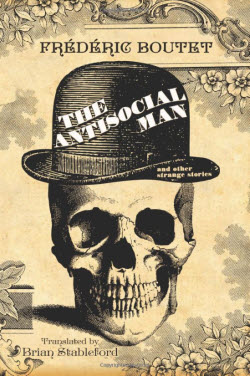Review by Glenn Russell
Singular tales told in rich,
opulent language, January 12, 2014
Perhaps it would be appropriate
to have this book of Frederic Boutet's rococo tales fitted with a fine
cover of black leather inlaid with golden arabesques, and then, after
partaking of a tincture of opium or wine, book in tremulous hand, surrounded
by odiferous flowers and pungent perfumes, in solitude, at midnight, by
the light of a solitary candle, take a seat in a plush chair. With these
modest preparations - the decorated cover, lavish ambience and one's inner
hypersensitive state - a reader will begin to match the author's ornate
sentences and baroque storytelling.
Indeed, if you have a taste
for the fantastic, for gothic horror, for weird characters and arcane
landscapes described in rich, opulent language, for a book that could
be sub-titled `Deadly Beauty', then this collection translated and introduced
by Brian Stableford and published by Borgo Press might become one of your
very favorites. By way of specific examples, here are a few quotes and
my comments on three of the thirteen tales:
The Veritable Victory
A pale-faced, black-bearded visitor removes his top hat and cloak and
is lead to a room where a young woman of great beauty, dead to all appearances,
lies on an ivory bed with lace pillows and satin sheets. We read, "He
thought: What does tomorrow matter? She is beautiful tonight; she is all
mine; and I shall love her until I vanquish death!" And then we read,
"He possessed her in a voluptuous delirium multiplied tenfold by
opium." We know right from the outset this is a scene that has been
repeated many time before: the visitor is lead into the house by a horror-struck
old housekeeper and the woman lies on the bed as if dead. But then one
night there is an unexpected change. The author writes, "But he exhausted
himself in vain in gluing his lips to the pale mouth; she did not part
her own any more. In vain, he caressed the voluptuous body passionately,
but she did not quiver and her arms did not return the embrace. The translucent
eyelids remained closed over the large blue eyes, the little feet were
icy, the limbs became ever colder, ever heaver." One senses Boutet
coated every sentence of his sumptuous, extravagant tale with overpowering
cologne and death.
The Idol
Lost in a forest, a mounted traveler by the name of Jean Falmor encounters
ugly, stinking creatures gnawing on roots. He then comes upon Marestote,
a holy black monk, a monk who tells Falmor how the brutish half-men he
now sees crawling around the fires had their souls devoured by a fatal
power: Woman. Confidence in his holiness and Christian mission, Marestote
invites the traveler to join him in his confrontation with his evil enemy.
At the point in the story when the black monk challenges the Woman, Boutet
describes what these two men see when the Woman displays her miraculous
naked beauty: "The whiteness of her skin is mat and polished, with
a gilded roseate translucency. Above her arched feet, resting on a swans-down
carpet, the slimness of her ankles elongates and folds back lazily. Then,
there is the gracious grasp of the knee and the voluptuous plentitude
of thighs; the skin is as delicate as the most adorable silk, seemingly
warm and perfumed, and the delight of its touch must be superior to any
other." This is but one paragraph of description; Boutet goes on
to further describe the Woman (author's capitalization) in equally florid
language in five more paragraphs. Not only does this tale contain a most
exquisite description of female beauty but also will prompt us to reflect
on our philosophical and theological presuppositions.
The Antisocial Man of the
Qual Bois-L'encre
This Boutet story is decidedly unlike the others in the collection in
a couple of ways - first, at 72 pages, it is a much longer piece; and,
second, the story is a mad-cap cross between two forms, what would come
to be known in the 20th century as 1) South American magical realism,
and 2) Soviet absurdist fiction. To underscore this point, the story's
characters provide reports not only on the Antisocial Man, a recluse isolating
himself in a top floor apartment, but also creatures sharing the Antisocial
Man's living space, including a baboon, brown bear, anti-bear, hippopotamus,
kangaroo, goat, boa constrictor, armadillo and a bearded vulture. And
what more detail do we have on the Antisocial Man? Here is a description
from a bailiff's notebook: "The Antisocial Man, as I've said, is
not mad. At the very moment when I am writing these lines I can see him
through the foliage, a short distance away. He is sitting on the edge
of the spring. He is thin, beardless, muscular, sardonic and calm. He
is smoking his pipe. His clothing is simple. He rarely speaks. Sometimes
he reads books. At his feet is his favorite goat: a very young, very pretty,
very affectionate and very capricious goat, which never leaves him for
long and for which he appears to have, doubtless in imitation of Robinson
Crusoe, an excessive tenderness." You may ask: how can an apartment
have foliage and a spring? Again, this is a work of sheer imaginative
fancy, an occasion for our singular author to stretch his creative powers
and literary inventiveness.
|


